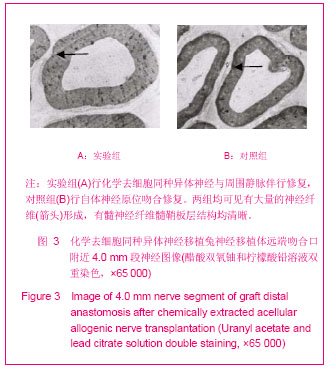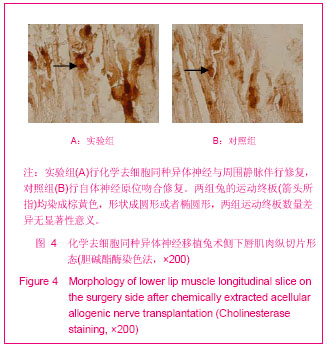| [1] Vleggeert-Lankamp CL. The role of evaluation methods in the assessment of peripheral nerve regeneration through synthetic conduits: a systematic review. Laboratory investigation. J Neurosurg. 2007;107(6):1168-1189.[2] Niu XF, Liu XL, Hu J. Zhongguo Xiufu Chongjian Waike Zazhi. 2009;23(2):235-238.牛晓锋,刘小林,胡军,等.大鼠化学去细胞异体神经再血管化的实验研究[J].中国修复重建外科杂志,2009,23(2):235 -238.[3] Lundborg G. A 25-year perspective of peripheral nerve surgery: evolving neuroscientific concepts and clinical significance. J Hand Surg (Am). 2000;25(3):391-414.[4] Abo-Auda W, Benza RL. Therapeutic angiogenesis: review of current concepts and future directions. J Heart Lung Transplant. 2003;22(4):370-382.[5] Sun XM, Tang JS, Xu WJ, et al. Zhonghua Guke Zazhi. 2006; 26(4):267-271.孙明学,唐金树,许文静,等.化学去细胞同种异体神经移植的实验研究[J].中华骨科杂志,2006,26(4):267-271.[6] Liu HF, Hu M, Liu HC, et al. Kouqiang Yixue Yanjiu. 2007;23(6): 659-661.刘洪飞,胡敏,刘洪臣,等.同种异体神经行面神经缺损修复的初步应用[J].口腔医学研究,2007,23(6):659-661.[7] Yang XX, Leng Z, Qian T, et al. Zhongguo Xiufu Chongjian Waike Zazhi. 2006;20(3):295-299.杨小祥,冷震,钱塘,等.超低温冷冻保存的吻合血管异体神经移植实验研究[J].中国修复重建外科杂志,2006,20(3): 295-299.[8] Ide C, Tohyama K, Tajia K. Long acellular nerve trans-plants for allogeneic grafting and the effects of basic fibroblastgrowth factor on the growth of regenerating axons in dogs: a pre-liminary report. Exp Neurol. 1998;154(1):99-122.[9] Jakse N, Payer M, Tangl S, et al. Influence of low-level laser treatment on bone regeneration and osseointegration of dental implants following sinus augmentation. An experimental study on sheep. Clin Oral Implants Res. 2007;18(4):517-524.[10] Stein E, Koehn J, Sutter W, et al. Initial effects of low-level laser therapy on growth and differentiation of human osteoblast-like cells. Wien Klin Wochenschr. 2008;120(3-4): 112-117.[11] Liu SQ, Zhang SS, Peng H, et al. Zhonghua Shouwaike Zazhi. 2004;20(2):110-113. 刘世清,张思胜,彭昊,等.无细胞的异体神经修复鼠坐骨神经缺损[J].中华手外科杂志,2004,20(2):110-113 .[12] Song XZ, Gu YD, Hu SN. Zhonghua Shouwaike Zazhi. 2001; 17(1):39.宋修竹,顾玉东,胡韶楠.神经再生室中神经再生过程和微环境的研究[J].中华手外科杂志,2001,17(1):39.[13] Taylor GI, Ham FJ. The free vascularized nerve graft. Afurther experimental and clinical application of microvascular techniques. Plast Reconstr Surg. 1976;57(4):413-426.[14] Chen Q, Hu YM, Zhong SZ. Zhongguo Linchuang Jiepou Zazhi. 1992;10(2):133-135.陈强,胡耀民,钟世镇.血管与周围神经再生的关系[J].中国临床解剖学杂志,1992,10(2):133-135.[15] Sun Q, Zheng JF, Zhao CM. Zhongguo Xiufu Chongjian Waike Zazhi. 2012;26(7):839-843.孙强,郑加法,赵昌明.移植段神经与周围静脉伴行修复长段周围神经缺损的实验研究.中国修复重建外科杂志,2012,26(7):839-843.[16] Spector JG,Lee P,Derby A. Rabbit facial nerve regeneration inautologous nerve grafts after antecedent injury. Laryngoscope. 2000;110(4):660-667.[17] Olssony Y. Microenvironment of the peripheral nervous system under normal and pathological conditions. Grit Rev Neurobiol. 1990;5(3):265-270.[18] Sun XH, Dou WB, Tong XJ, et al. Zhongguo Linchuang Kangfu. 2006;10(29):19-21孙晓红,窦文波,佟晓杰,等.许旺细胞与脱细胞神经移植物共培养在周围神经损伤修复中的作用[J].中国临床康复,2006,10(29): 19-21.[19] Li GK, Yu NS, Li W. Zhongguo Xiufu Chongjian Waike Zazhi. 2007;6(21):577-581.李根卡,余楠生,黎文.许旺细胞和生物蛋白胶构建组织工程神经的初步研究[J].中国修复重建外科杂志,2007,6(21):577-581.[20] Evans PJ, Midha R, Mackinnon SE. The peripheral nerve allograft: a comprehensive review of regeneration and neuroimmunology. Prog Neurobiol. 1994;43(3):187-233.[21] Whitworth IH, Dore C, Hall S, et al. Different muscle graft denaturing methods and their use for nerve repair. Br J Plast Surg. 1995;48(7):492-499.[22] Liu JM, Peng W, Wang ZL. Linchuang Waike Zazhi. 2002; 10(4):227-228.刘金慕,彭吴,王志林.甘油处理的同种异体神经在临床的应用[J].临床外科杂志,2002,10(4):227-228. [23] Hao GF, Xin CT, An GL, et al. Zhonghua Shouwaike Zazhi. 2000;16(2):123-125.郝桂芬,辛畅泰,安贵林,等.受体血浆冷存异体神经桥接神经缺损的形态学研究[J].中华手外科杂志,2000,16(2):123-125. [24] Li JM, Yao JM, Song JL, et al. Zhejiang Linchuang Yixue Zazhi. 2000;2(4):222.李建兵,姚建民,宋建良,等.放射辐照对异体神经移植影响的实验研究[J].浙江临床医学杂志,2000,2(4):222. [25] Li TX, Yuan J, Zhang XD, et al. Zhongguo Linchuang Kangfu. 2004;8(28):6117-6119.李天侠,袁杰,张晓东,等.紫外线B照射低温冷冻同种异体神经移植的实验研究[J].中国临床康复,2004,8(28):6117-6119. [26] Song XZ, He CQ, Gu YD.Zhonghua Shiyanwaike Zazhi. 1998;15(3):263.宋修竹,贺长清,顾玉东.酒精处理的同种异体周围神经移植的研究[J].中华实验外科杂志,1998,15(3):263. [27] Gu YR, Jiang AM, Zhu TL. Chuangshang Waike Zazhi. 2002;4(1):31-34.顾玉荣,蒋安明,朱天亮.低温冷冻和酒精处理的同种异体周围神经移植的效果比较[J].创伤外科杂志,2002,4(1):31-34. [28] Dumont CE, Hentz VR. Enhancement of axon growth by detergent-extracted nerve grafts. Transplantation. 1997;63(9): 1210-1215. [29] Sondell M, Lundborg G, Kanje M. Regeneration of the rat sciatic nerve into allografts made acellular through chemical extraction. Brain Res. 1998;795(1-2):44-54. [30] Dai CC, Wang W, Cao YL, et al. Zhonghua Zhengxing Waike Zazhi. 2001;17(6):366-368.戴传昌,王炜,曹谊林,等.去细胞异体神经基膜管桥接神经缺损的实验研究[J].中华整形外科杂志,2001,17(6):366- 368. [31] Liu CJ, Sun JZ, Tong XJ, et al. Jiepou Kexue Jinzhan. 2003; 9(3):197-200.刘承吉,孙景致,佟晓杰,等.组织工程化天然神经支架的制备[J].解剖科学进展,2003,9(3):197-200. [32] Sun HZ, Tong XJ. Jiepou Kexue Jinzhan. 2001;7(4):331-334.孙慧哲,佟晓杰.脱细胞处理的同种异体神经移植研究进展[J].解剖科学进展,2001,7(4):331-334. [33] Sun XH, Tong XJ, Zhang CS, et al. Zhongguo Yike Daxue Xuebao. 2005;34(1):6-9.孙跷红,佟晓杰,张彩顺,等.脱细胞同种异体神经移植物桥接大鼠坐骨神经缺损的形态学观察[J].中国医科大学学报,2005,34(1):6-9.[34] Tong XJ, Zhang CS, Cao DS, et al. Jiepou Xuebao. 2005;36 (1):1-5.佟晓杰,张彩顺,曹德寿,等.脱细胞异体神经移植物桥接大鼠坐骨神经缺损促进神经肌结构重建和功能恢复的实验研究[J].解剖学报,2005,36(1):1-5. [35] Liu JC, Lin XP, Tong XJ, et al. Jiepou Kexue Jinzhan. 2005; 11(3):206-209.刘金超,林晓萍,佟晓杰,等.脱细胞异体神经基质移植物对脊髓前角运动神经元的保护作用[J].解剖科学进展,2005,11(3):206-209. [36] Zhong HB, Lu SB, Hou SX, et al. Zhonghua Shouwaike Zazhi. 2002;18(3):131.衷鸿宾,卢世璧,侯树勋,等.犬化学去细胞神经同种异体移植的神经再生研究[J].中华手外科志,2002,18(3):131. [37] Yu HL, Peng J, Sun HY, et al. Zhongguo Xiufu Chongjian Waike Zazhi. 2008;22(11):1373-1377.于海龙,彭江,孙华燕,等.化学去细胞同种异体神经复合缓释神经生长因子修复周围神经缺损[J].中国修复重建外科杂志,2008, 22(11):1373-1377.[38] Hudson TW, Zawko S, Deister C, etal. Optimized acellular nerve graft is immunologically tolerated and supports regeneration. Tissue Eng. 2004;10(11-12):1641-1651. [39] Zhong HB, Lu SB, Hou SX, et al. Zhonghua Waike Zazhi. 2003;41(1):60.衷鸿宾,卢世璧,侯树勋,等.人类去细胞同种异体神经移植物化学萃取方法的研究[J].中华外科杂志,2003,41(1):60.[40] Chen GJ, Zhu QS, Xu XZ, et al. Zhongguo Jiaoxing Waike Zazhi. 2007;15(7):541-544.陈冠军,朱庆生,徐新智,等.优化法去细胞大鼠神经同种异体移植修复坐骨神经缺损[J].中国矫形外科杂志,2007,15(7):541-544. [41] Qin CJ, Wang W, Li HY, et al. Zhongguo Yixue Gongcheng. 2006;14(4):340-342.秦长江,王伟,李宏义,等.改良去细胞同种异体神经移植后免疫反应的观察[J].中国医学工程,2006,14(4):340-342.[42] Niu Y, Hu M, E LL, et al. Zhongguo Kouqiang Hemian Waike Zazhi. 2008;6(2):114-118.牛宇,胡敏,鄂玲玲,等.去细胞异体面神经移植修复兔面神经缺损的实验研究[J].中国口腔颌面外科杂志,2008,6(2):114-118.[43] Hudson TW, Zawko S, Deister C, et al. Optimized acellular nerve graft is immunologically tolerated and supports regeneration. Tissue Eng. 2004;10(11-12):1641-1651.[44] Yao J, Lin XZ, Shi W, et al. Zhongguo Xiufu Chongjian Waike Zazhi. 2008;22(9):1068-1072.姚健,林潇哲,施伟,等.大鼠陈旧性坐骨神经缺损修复期限的实验研究[J].中国修复重建外科杂志,2008,22(9):1068-1072.[45] Zhao DW, Du GJ, Zhang XM, et al. Zhonghua Chuangshang Zazhi. 1996;12(1):37-39.赵德伟,杜国君,张晓明,等.血管束植入移植神经修复周围神经缺损[J].中华创伤杂志,1996,12(1):37-39.[46] The Ministry of Science and Technology of the People’s Republic of China. Guidance Suggestions for the Care and Use of Laboratory Animals. 2006-09-30. |




.jpg)